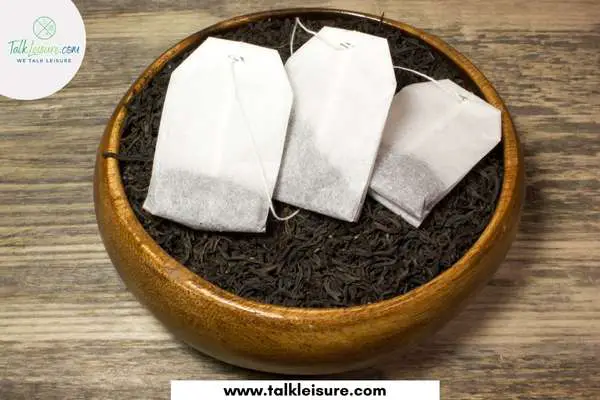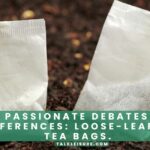Teabags are small, paper pouches that hold dried tea leaves. They were invented in 1908 by Thomas Sullivan, an American tea merchant. Sullivan was shipping tea to clients in small silk pouches, but some of his clients thought the pouches contained coffee. When they brewed the tea, it came out strong and bitter. Sullivan soon realized that the silk pouches were actually causing the bitter taste and came up with the idea of using paper pouches instead.
One-cup tea bags are a newer type of teabag that is designed for people who want to make a single cup of tea. One-cup tea bags are usually smaller than regular tea bags, and they usually come in a box or sachet that contains 20-30 bags. One-cup tea bags can be used to make any type of tea, but they work best with black and green teas. Also, One-cup tea bags are a convenient way to make a single cup of tea without having to use a teapot or steep for a long time. And since they come in a small package, they are perfect for travelling or taking to work.
Types of Tea Bags

Today, there are all sorts of different kinds of tea bags, including pyramid-shaped teabags, round-shaped teabags, teabags with FlavorPrints, compostable and nylon tea bags, etc. But the most popular type of tea bag is the standard, square-shaped tea bag.
By its shape…
– Pyramid-Shaped Teabags: These tea bags are designed to allow more room for the tea leaves to expand, which results in a better flavour.
– Round-Shaped Teabags: These teabags are round instead of square, and they are often made from cotton or other natural fabrics. They are less common than square-shaped tea bags, but they are still popular among tea drinkers.
– Square-Shaped Teabags: These are the most common type of teabags, and they are made from thin, porous paper.
By its material…
– Paper Tea Bags: The most common type of tea bag is the paper teabag. Paper tea bags are made from lightweight paper, and they are often coated with a layer of plastic to prevent the tea leaves from escaping. They are inexpensive to produce, and they come in a variety of different sizes and shapes.

– Cotton Tea Bags: Cotton tea bags are made from cotton, and they are often filled with a blend of different tea leaves. They are more expensive to produce than paper tea bags, but they often have a better flavour and they are biodegradable.
– Silk Tea Bags: Silk tea bags are made from silk, and they are often filled with a blend of different tea leaves. They are the most expensive type of tea bag, and they often have a better flavour than paper or cotton teabags. However, they are not biodegradable, and they are not as common as other types of teabags.
– Nylon Tea Bags: Nylon tea bags are made from nylon, and they are often filled with a blend of different tea leaves. They are the most common type of teabag in the world, and they come in a variety of different sizes and shapes. Nylon tea bags are not biodegradable, but they can be recycled.

– Compostable Tea Bags: Compostable tea bags are made from compostable materials and are designed to be easily recycled or disposed of. They are not as common as other types of teabags, but they are becoming more popular among eco-conscious tea drinkers.
One-cup teabags producers in the market?
Some well-known one-cup tea bag producers in the market include Tetley Tea, Republic of Tea, PG Tips, and David’s Tea. Each offers a variety of unique flavours and blends to choose from. Whether you prefer black, green, or herbal tea, there’s definitely a one-cup teabag option out there for you!
Recommended Products:
01. Tetley Tea

Tetley One-Cup Tea is the perfect way to enjoy a great cup of tea anytime. Our master blenders have been perfecting Tetley’s smooth, full-flavoured tea for over 180 years. Our tea leaves are carefully picked from around the world, creating the unique Tetley colour and taste. The tea leaves are simply picked, cut and dried – making them 100% natural. At Tetley, we’re proud to bring you a great cup of tea that not only tastes delicious but also supports better lives for the people who grow and pick it.
02. PG Tips

At PG Tips, we’ve been making a quality tasting cuppa for 85 years. When it comes to tea, PG Tips know stuff – and that’s why our Pyramid Tea Bags let tea roam free. Acting as a mini teapot, the pyramid-shaped bag allows our finest tea leaves room to move and infuse, giving you an ideal tasting cuppa each and every time. Plus, with the Rainforest Alliance seal of approval proudly displayed on our packaging, you can rest assured that your purchase is helping to preserve the planet too!
One-cup teabags use by?

One-cup teabags are mostly used by caterers, hotels, and offices. They are also popular among people who want to make a single cup of tea without having to use a teapot or steep for a long time. Also, it’s ideal for people who love to drink light tea because, as discussed, one-cup teabags usually come with less tea than regular. Finally, since they come in a small package, they are perfect for travelling or taking to work.
One-cup teabag or a regular tea bag is better?
In an aspect of an average user, A regular tea bag!
A one-cup teabag is meant for a single cup of tea, while a regular tea bag is meant for multiple cups. A one-cup teabag typically has a more concentrated flavour and less caffeine than a regular tea bag. Additionally, the one-cup teabag often becomes bitter if brewed for too long, while the regular tea bag can be brewed multiple times without becoming bitter.
One-cup teabag steep in two teacups?

Brewing a one-cup teabag for two cups will not produce the desired results. The tea will be weak and watery, and the bag will likely become bitter if brewed for too long. A one-cup teabag is meant for a single cup of tea, not multiple cups. If you want to make more than one-cup of tea, use a regular tea bag. It will produce a better-quality cup of tea and can be brewed multiple times without becoming bitter.
Minimum quantity in a one-cup teabag?
The minimum quantity of tea in a single-cup teabag is typically about 1.5 grams. However, there can be some variation depending on the type of tea and the brand. For example, black tea might have a higher minimum quantity than green or chamomile tea. Therefore, the maximum of a one-cup teabag will hold between 2 and 3 grams of tea.
Squeeze your teabags?

Yes, it’s okay to squeeze teabags. In fact, most people do it without even realizing it. When you’re done brewing your tea, just give the bag a gentle squeeze and then toss it in the trash. This will help extract as much of the tea’s flavour as possible.
Weak tea or strong tea is healthier?
There is no definitive answer when it comes to which type of tea is healthier, weak or strong. Ultimately, it comes down to personal preference and what you enjoy drinking. Some people believe that weak tea is healthier because it contains less caffeine than strong tea. However, others believe that strong tea is healthier because it contains more antioxidants than weak tea. Ultimately, it comes down to what you prefer and what you think is healthier for you.
The proper way of making tea with a one-cup teabag?
The proper way of making tea with a one-cup teabag is to place the bag in a cup, add hot water, and let it steep for 3-5 minutes. You can then drink the tea directly from the cup or pour it into another container. Finally, add sugar for your taste. Be sure not to over brew the tea, as it will become bitter if brewed for too long. Additionally, do not make two teacups per one teabag; as discussed, it will produce weak and watery tea. If you want to make more than one-cup of tea, use a regular tea bag instead.
Wants to identify toxins in teabag material?
Some toxins which can be found in teabag material are heavy metals like lead, arsenic and cadmium. Other toxins that might be present include residual pesticides and fertilizers and other chemicals used in the manufacturing process.
To avoid exposure to these toxins, it’s important to choose tea brands that are USDA certified organic. This certification guarantees that the tea has been grown without the use of chemical pesticides, herbicides or fertilizers. It also means that the tea is processed using environmentally friendly methods, without the use of harmful solvents or chemicals.












